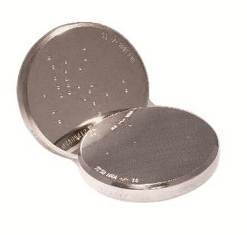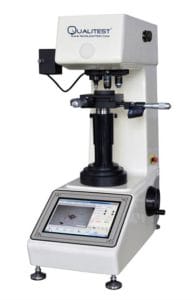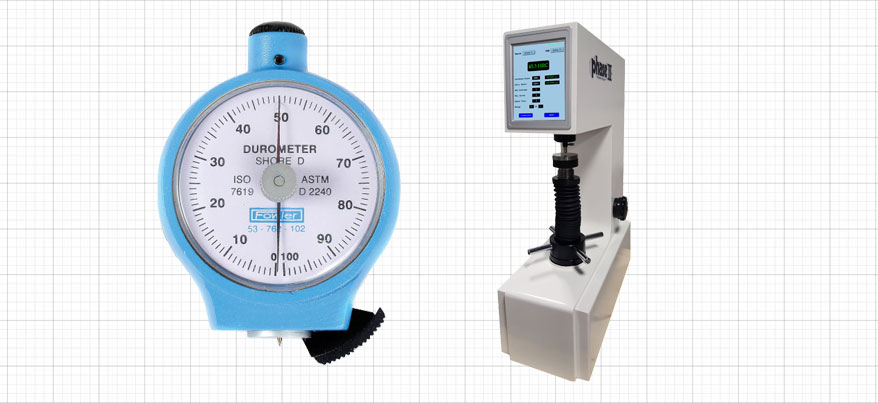In metrology, people tend to have a hardness scale that they prefer. Perhaps it is due to the field they work in, or maybe it comes down to personal preference. However, having an understanding of all the different hardness scales that are out there is important for anyone working in metrology. Whether you need to convert a hardness measurement for a customer, understand what the hardness is of a material provided in a different scale, or translate the meaning of a scale used by a collaborating business, knowing what each of the hardness scales is and how it works will improve your ability to do business. Today we are going to talk about the six main hardness scales: Rockwell, Vickers, Brinell, Mohs, Knoop, and Shore.
Introduction to the Hardness Scales
Hardness refers to the ability of a certain material to resist indentations or scratches. Each material you use has a hardness value that is determined through specific testing. The different testing procedures available result in a value that lies on a particular scale. Therefore, each hardness test comes paired with a hardness scale. These hardness scales are called the Rockwell hardness scale, the Vickers hardness scale, the Brinell hardness scale, the Mohs hardness scale, the Knoop hardness scale, and the Shore hardness scale. Which of these six scales is best for a job at hand depends on both the material being tested and what equipment is going to be doing the testing. In general, testing involves applying a particular tool to a material at a certain pressure for a certain amount of time. We will now discuss these different methods and scales in more detail.
Rockwell Hardness Scale
The Rockwell hardness scale is the most widely used hardness scale. The Rockwell hardness test provides the fastest and most accurate way to test the hardness of a material and takes place over three stages. In stage one, a load of force is applied to the material being tested for a short period of time, commonly using a diamond or ball indenter to apply the force. In stage two, the force being applied is increased and is called the major load. In stage three, the major load is removed from the material being tested and the original smaller load of force is applied once again. After this process is complete, the resulting indentation is measured and used to calculate the difference between the final and original indentation depths. The force applied using the indenting tool typically ranges between 15kgf and 3000kgf. There are several different Rockwell hardness scales, each identified by the use of a letter including A, B, C, D, E, F, G, H, and K.

Vickers Hardness Scale
The Vickers hardness scale was developed as an alternative to the Brinell hardness scale by Robert L. Smith and George E. Sandlord at Vickers Ltd. Typically used when measuring the hardness of small or thin materials, the Vickers hardness test is sometimes called the microhardness test. To test the hardness of a material, a light force is applied using a diamond indenter and the resulting depth is measured optically. The test force (N), the depth of the indentation (mm), and the length of the diagonals of the indentation (mm) are used to calculate the Vickers hardness scale measurement. The applied force generally falls between 10g to 1kgf, but can be as high as 30kgf when wanting to apply a larger force load. The resulting hardness as measured with the Vickers hardness scale is reported using the format xxxHVyy, where “xxx” is the hardness number and “yy” is the force load used in kgf. When the length of time that the force was applied is different than 10 to 15 seconds then that is noted using xxxHVyy/zz where “zz” reports the force load duration in seconds.

Brinell Hardness Scale
The Brinell hardness scale was the first standardized hardness scale to be widely applied and was proposed by Johan August Brinell in the year 1900. When completing the Brinell hardness test, a carbide ball indenter is pressed into the surface of the material being tested using a constant applied force for a set amount of time. The resulting indentation can then be measured and the outcome can be used to calculate the eventual hardness value. The calculation used involves value of the test force (N), the diameter of the carbide ball indenter (mm), the diameters of the indentation caused in two directions at right angles to one another (mm), and the depth of the indentation (mm). The force applied tends to range between 500 kgf for non-ferrous metals and 3000 kgf for steel. The Brinell hardness scale value, or the Brinell hardness number, reflects the resulting hardness of the test material. Advantages of the Brinell hardness scale include its applicability to non-homogenous materials and its allowance for the use of different forces and different indenters. The disadvantages of the Brinell hardness scale include the slowness of completing the Brinell hardness test and the destructiveness of the test indentation.
Mohs Hardness Scale
The Mohs hardness scale is an ordinal scale that ranges from 1 to 10 with 1 being the least hard and 10 being the hardest. The Mohs hardness test involves attempting to scratch the material being tested with another material. Developed by Friedrich Mohs in 1812, the Mohs hardness scale is more qualitative in nature and not the most reliable method for measuring hardness. The technical scale ranges across different minerals increasing in hardness—talc, gypsum, calcite, fluorite, apatite, feldspar, quartz, topaz, corundum, and diamond. Seeing as many of these minerals are hard to come by, typically a comparable material such as a fingernail or a hard file will be used. Starting with the softer end of the Mohs hardness scale and working your way up until a permanent indentation is achieved, you can determine the hardness of a specific material.
Knoop Hardness Scale
The Knoop hardness test is intended for use with small and thin materials as the force applied to determine hardness is 1kgf or less. Very similar to the Brinell hardness test in method, the Knoop hardness test involves an indenter shaped like rhombus and a microscope. The formula to calculate a measurement using the Knoop hardness scale includes the length of the indentation along the long axis, the correction factor related to the shape of the indenter (typically 0.070279), and the load of force applied. The value on the Knoop hardness scale is noted using HK or KHN and most often falls between 100 and 1000. The main advantage of using the Knoop hardness scale is that only a very small sample of the test material is required to get a measurement. The main disadvantage of the Knoop hardness scale is the challenges of using a microscope to complete the measurement and the time required.
Shore Hardness Scale
There are two main Shore hardness scales, Shore A hardness scale and Shore D hardness scale. The Shore A hardness scale is typically used when working with soft polymers and elastomers, while the Shore D hardness scale is more often used when working with hard polymers such as thermoplastics. The Shore hardness scales range from a minimum hardness of 0 to a maximum hardness of 100. When a material has a Shore hardness scale measurement of 100 this means that the material has no penetration during testing. The Shore hardness test involves an indenting machine that is spring-loaded to bear a pre-determined degree of pressure with different indenter tip shapes depending on whether you are using Shore A or Shore D.
Conclusion
The different hardness tests and resulting hardness scales are empirical in nature and require the comparison of two materials of differing hardness. The values denoted by the different hardness scales are crucial to explain hardness as hardness is not an intrinsic value present in a material, but rather a quality comparing one material to another. The Rockwell hardness scale, the Vickers hardness scale, the Brinell hardness scale, the Mohs hardness scale, the Knoop hardness scale, and the Shore hardness scale each come with unique applications and should denote the method used to complete the hardness test. For some, the tried and true scale that applies to commonly used materials may be preferred. For others, knowing the ins and outs of comparisons across the different hardness scales may be more useful and exciting. Contact the Higher Precision team today if you have questions about the different hardness scales or how to apply them.
FREQUENTLY ASKED QUESTIONS
- What are the different hardness scales and why are there so many?
The six main hardness scales are the Rockwell hardness scale, the Vickers hardness scale, the Brinell hardness scale, the Mohs hardness scale, the Knoop hardness scale, and the Shore hardness scale. While there is no one reason why there are so many different ways to test and measure hardness, one explanation relates to technological advancement over time and the particulars involved in any measurement situation. Some of the older hardness scales, such as the Brinell hardness scale, may be reliable to use, but come with disadvantages like the slowness to complete the test. Additionally, some of the hardness scales are simply not suited to certain kinds of hardness measurement. If you are working with thin, small, or delicate materials you will need to choose either the Vickers hardness scale or the Knoop hardness scale, as these utilize less force than the others. If you are completing a great number of hardness measurements, the Rockwell hardness scale is probably the best choice due to its speed and accuracy. Depending on the type of hardness measurement you are completing, the hardness scale you should use will change.
- Which hardness scale is the most commonly used and why?
The Rockwell hardness scale is likely the most common hardness scale used today. A highly accurate and fast method of testing hardness, the Rockwell hardness test is used across a number of metrological settings and so you often see hardness represented using the Rockwell hardness scale. Information collected about hardness relates to other factors held by a material including strength, resistance, and ductility, making precision highly important. The differential depth measurement concept for hardness that is used by the Rockwell hardness scale was first developed by Pail Ludwik in 1908. Then, Hugh Rockwell and Stanley Rockwell co-invented a machine called the Rockwell hardness tester, which was patented in 1914, that implemented the differential depth measurement concept. The Rockwell hardness scale is defined by the standard American Society for Testing and Materials (ASTM) E18 and approved for measurement of commercial shipments, making it highly utilized. Getting a reliable Rockwell hardness scale value requires that the test materials be at least 10 times the depth of the indentation being made and the material must be measured on a flat and perpendicular surface.
- What are the issues involved in conversion between these different hardness scales?
Developing a uniform and reliable way to measure hardness that can replace the many hardness scales available has been a discussion in the metrology field for a long time. However, little progress has been made in finding a solution. The Rockwell hardness scale, the Vickers hardness scale, the Brinell hardness scale, the Mohs hardness scale, the Knoop hardness scale, and the Shore hardness scale each come with pros and cons, and creating a uniform method that combines them may be impossible. Therefore, conversion between the different hardness scale remains common practice. The central problem with conversion is there is no definitive way to clearly convert one hardness scale value to another without a small amount of variation. This variation can have a lasting impact on acceptance or rejection of parts with specified requirements. Conversion tables exist and are currently the best option. Importantly, knowing and understanding the differences between hardness scales and how hardness is tested will be crucial to making the best conversion decisions possible and ensuring as much accuracy as possible.
GLOSSARY TERMS
- Rockwell Hardness Scale
The Rockwell hardness scale is one way in which the hardness of a material is represented numerically. Hardness is the resistance of a material to indentation and is measured by the permanent depth of an indentation that has occurred. The Rockwell hardness scale is the most common way to measure the hardness of a material. Through the application of a diamond indenter, first with a preliminary load and then with a major load, an indentation difference is calculated to determine the final Rockwell hardness scale measurement.
- Vickers Hardness Scale
The Vickers hardness scale is one way in which the hardness of a material is represented numerically. Hardness is the resistance of a material to indentation and is measured by the permanent depth of an indentation that has occurred. The Vickers hardness scale value is determined by what is sometimes called a microhardness test and is particularly well-suited for small or thin materials. The indentation resulting from the application of a light force is measured using a microscope and used to determine the Vickers hardness scale measurement.
- Brinell hardness scale
The Brinell hardness scale is one way in which the hardness of a material is represented numerically. Hardness is the resistance of a material to indentation and is measured by the permanent depth of an indentation that has occurred. The Brinell hardness scale was the first type of hardness scale used widely. A Brinell hardness scale measurement is determined by applying a carbide ball indenter into the surface of the material being tested with a force ranging between 500kgf and 3000kgf.
- Mohs Hardness Scale
The Mohs hardness scale is one way in which the hardness of a material is represented numerically. Hardness is the resistance of a material to indentation and is measured by the permanent depth of an indentation that has occurred. The Mohs hardness scale rates the hardness of material from 1 to 10 using the ability of another material to scratch the test material. Typically used in geological contexts, the Mohs hardness scale ranges from talc to gypsum to calcite, to fluorite, to apatite, to feldspar, to quartz, to topaz, to corundum, to diamond.
- Knoop Hardness Scale
The Knoop hardness scale is one way in which the hardness of a material is represented numerically. Hardness is the resistance of a material to indentation and is measured by the permanent depth of an indentation that has occurred. The Knoop hardness scale can be tested using similar methods to the Brinell harndess scale. However, the Knoop hardness scale uses an indenter that is shaped like a rhombus and is particularly useful for small, thin, or delicate materials that require a force load of 1kgf or less.
- Shore Hardness Scale
The Shore hardness scale is one way in which the hardness of a material is represented numerically. Hardness is the resistance of a material to indentation and is measured by the permanent depth of an indentation that has occurred. The Shore hardness scale includes a Shore A scale used for soft polymers and elastomers as well as a Shore D scale used for hard polymers. A Shore hardness scale value ranges between a minimum of 0 and a maximum of 100, and is determined by the amount of penetration from a needle-shaped indenter tip.

